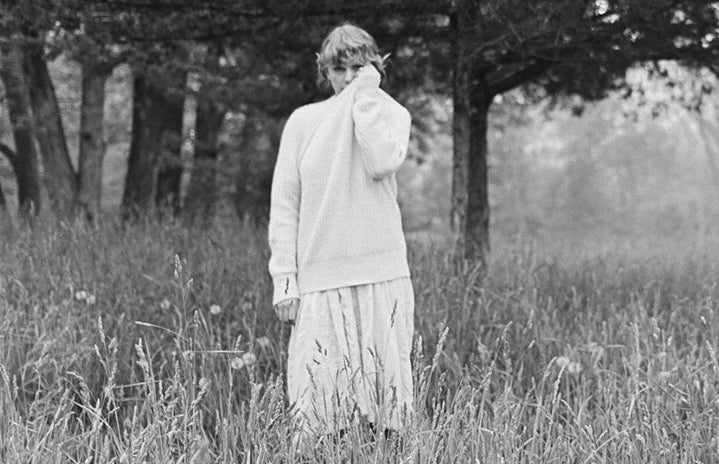In March of 2020, it didn’t seem like the year would hold much to look forward to. Jobs, relationships, educations and lives were put on hold for the COVID-19 crisis, and it seemed that art and culture were a thing of the past — a semantic relic that we gave up but didn’t think too much about.
By May and June, concert cancellations and the shuttering of musical and cultural institutions were simply run-of-the-mill news. During the “first wave” in the United States, there were some straggling releases of new music and TV shows that had been slated for massive openings, but the country went through what seemed to be a creative drought for a few months. As it turns out, that period gave us something to ease the pain and numbness of isolation, and we have Taylor Swift to thank for it.
Dropped into our laps like an early Christmas gift on July 24th, Folklore is a testament to how everyone’s minds looked during quarantine, put into musical form by the foremost songwriter of a generation.
The first album released by Swift that contained pieces overwhelmingly not about her own personal experiences (see the early breakup anthems of Fearless or Speak Now, as well as the transformation and catharsis of Reputation and Lover), fans and critics alike delighted in picking apart the messages behind the lyrics in Folklore and found that Taylor Swift isn’t so different from the rest of us. The album contained songs about disintegrating marriages, childhood innocence, teenage love triangles and everything in between (including references to Swift’s relationship with boyfriend of four years, Joe Alwyn, and former business collaborators at Big Machine Records).
There was something for everyone in Folklore, as reflected by the album’s reach across genres to pull in new fans of Swift’s shift to a folksier, more relaxed style of music that felt like a matured version of songwriting for the artist. It broke the Guiness World Record for the largest single-day release by a female artist on Spotify, and spent eight weeks at number one on the Billboard 200 chart, the most prolonged stay of any album since 2017. People who weren’t previously fans became appreciative of the new music as the album crept its way into the collective psyche of Americans’ experience with coronavirus: any of the heartbreak, loneliness, relief, confliction and reinvention we experienced during isolation can be found with the lyrics of Folklore.
Part of the perennial gift of following Taylor Swift’s work is the speculation- fans come up with wild theories, spurred on by the singer’s social media lurking and clues within musical content- and in 2020, the ability to make guesses and see our theories pan out was a blessing we didn’t know we needed. When there was so little anyone could control or feel confident in this year, seeing Taylor post a photo with the caption “not a lot going on at the moment” and then having fan speculations confirmed with the release of a new album a few weeks later gave us a feeling of not only normalcy and optimism, but a reminder that sometimes, life does actually work out in our favor.
The sounds of Folklore got us through the summer and fall into the darkness of winter and a second wave of COVID-19 even worse than the first (see Spotify’s year-end commercial about the song “august”) and on December 11, the surprise release of its sister album, Evermore, came right on the heels of a Disney+ special in which Swift and her collaborators Jack Antonoff and Aaron Dessner re-recorded a stripped-down Folklore at a studio in upstate New York. There’s typically a gap of two years between major release of content from Taylor Swift, and the rate at which projects were dropped this year was delightfully irregular.
Evermore explores a lot of the same themes as Folklore, and follows in the practice of songwriting about imaginary people and events that haven’t actually happened to Swift (a broken engagement, a young woman home for the holidays after trying to make it in Hollywood, and the revenge killing of a cheating husband are among the scenarios written about). Swift revealed on her social media platforms that she was inspired by the movies, television and books that she spent time with during isolation to write about the lives of others, and it has led to some of her most impressively complex lyricism of her career.
If the shift to indie pop marked a new era of maturity in the Taylor Swift universe, that maturity ushered in lyrics that had fans breaking out online dictionaries to decipher the meaning of the songs (and subsequently tweeting about it with hilarious enthusiasm). These albums weren’t written for Swift’s legacy of larger-than-life multinational stadium tours, and that’s what makes them such revelations in the landscape of culture during a global pandemic. When we were all forced into our homes and out of our normal routines, we turned to artists and creators to occupy the space left by the absence of milestones. Weddings, graduations, birthdays, funerals and all of the bigger moments in life had to be postponed and were replaced largely by hours spent watching TV, listening to music and reliving movies we hadn’t seen in awhile. The institution of family time boiled down to everyone bingeing the same show at once (in my family it was Tiger King) or putting on music while doing the dishes after a day of virtual work and school. It’s fitting that Taylor Swift released two albums that play best in houses, apartments, and the presence of people you’ve missed seeing.
Beyond all else, Folklore and Evermore expanded upon Swift’s role in her fans’ lives as the soundtrack to growing up. In the past, albums about relationships, growing close and apart from friends and personal reinvention have colored the relationship between the artist and the fans, but now the music and discourse is shaped by the mass common experience of living through a tumultuous year where millions of people discovered similarities they didn’t think they had with others. Listening to “invisible string” feels as integral to my 2020 experience as putting on two masks before walking into my summer job. Hitting play on “cardigan” or “the lakes” puts me back in mid-August and saying goodbye to my friends as they headed off to college, and I stayed home for an online semester. My midterms were marked by “exile” and my finals will be designated by “champagne problems” and “tis the damn season.” Taylor was singing about the pitfalls of mental health during isolation at the same time that I was struggling with my own emotions in a vacuum.
The music we listen to overwhelmingly helps us process the things we go through in life, and there was a lot of processing to do this year. When we figured out what it all meant for us, though, what was left was the hope and simple joy that comes with feeling understood by the art you consume. If there are parallels between my experiences and the ones of an artist I’ve loved since I was six years old (not to mention the legions of other fans online living similar lives to mine), my year feels a little bit less lonely and next year feels like a source of optimism. A great album can’t solve an economic crisis or the biggest public health challenge in a century, but it can make individuals within those issues feel more connected and, frankly, sane. So, at the close of 2020, I’m counting Taylor Swift next to any of the hundreds of movers and shakers who helped build something substantive in a year where circumstances were dedicated to tearing things down. Maybe it’s the rabbit hole of fan theories that I’ve fallen down on TikTok making me say this, but I have a feeling 2021 will yield similarly hopeful results.


